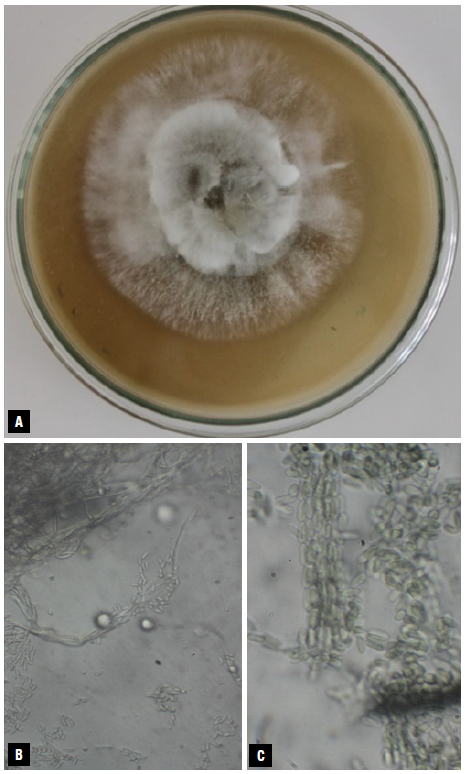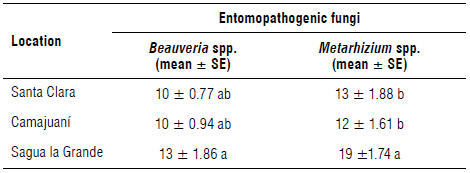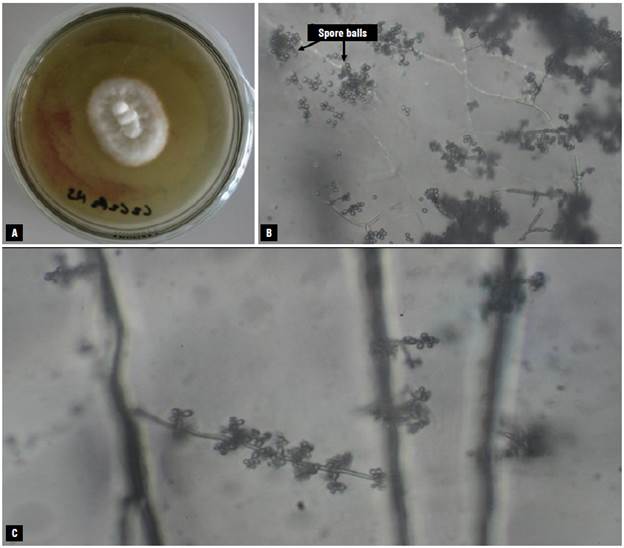Introduction
Entomopathogenic fungi constitute an important biotic component in the natural regulation of arthropod populations (Meyling & Eilenberg, 2007). Beauveria spp. have been found in several ecosystems worldwide including forest, seminatural habitats, and agricultural fields (Clifton et al., 2015). In contrast, Metarhizium spp. are more abundant in temperate regions, but not in colder regions (Steinwender et al., 2015).
These entomopathogenic fungi show potential as microbial control agents against different agricultural pests, and they can be artificially reproduced. Among the attributes of these fungi, we can mention a high mortality of the targeted pest population, high genetic diversity across a wide number of strains, infection of multiple life stages, penetration through the integument, and capacity for both horizontal and vertical transmission (Destefano et al., 2004; Jaronski, 2014).
The environmental and ecological variations within ecosystems have become a major factor influencing the biocontrol effects of Beauveria and Metarhizium species. A more detailed understanding of environmental and ecological interactions, especially the distributions of these fungi in different ecological areas, is needed to improve consistency in the control capacity of these fungi. In this sense, particular stages in the life cycle of Beauveria spp. and Metarhizium spp., including their persistence and dispersal in the environment, are unresolved in Cuba. The aim of this study was to evaluate the abundance of Beauveria spp. and Metarhizium spp. in maize (Zea mays L.) and banana (Musa paradisiaca L.) fields or agroecosystems. These are the most important crops in Cuba.
Materials and methods
Field sampling
Field samplings were conducted from April to July 2018 in three maize (Zea mays (L.), cv. 'Jibara') and three banana (Musa paradisiaca (L.), cv. 'Grande Naine') fields located in three municipalities in Villa Clara province, Cuba. The selected municipalities were Camajuani (22°28'4" N, 79°43'26" W), Santa Clara (22°24'49" N, 79°57'58" W) and Sagua la Grande (22°48'24" N, 80°4'32" W), where five collection points spaced 20 m apart were selected in each of the maize and banana fields. Two soil samples of 500 g each were collected with a garden spade around selected points to a depth of about 15 cm after removal of surface litter. The garden spade was disinfected with 70% ethanol between every collection to avoid contamination (Klingen et al., 2002). The soil samples from each point were placed into polyethylene bags and transferred to the Microbiology Laboratory at the Universidad Central "Marta Abreu" de Las Villas. Collected soil samples were thoroughly homogenized by hand and stored at 4°C until processing.
Isolation methods
The selective medium and the insect bait methods were used to isolate entomopathogenic fungi from soil samples. The first method was used through serial dilutions of soil in a culture medium, and the insect bait method employed the use of Galleria mellonella L. (Lepidoptera: Pyralidae) larvae. Galleria mellonella larvae were used for this purpose due to their high susceptibility to many fungal pathogens and because they are commercially reproduced in the Entomophagous and Entomopathogenic Reproduction Center in Cuba. A growth selective medium for Beauveria spp. and Metarhizium spp. was formulated using saboraud dextrose agar (SDA) (BioCen, Cuba) according to Meyling and Eilenberg (2007). The SDA culture medium was mixed with 1 mg L-1 (w/v) of thiabendazole, 0.05% streptomycin sulfate, and 250 mg L-1 (w/v) of chloramphenicol to avoid bacterial and some saprophytic fungi.
One g of each soil sample was placed in 20 ml of sterile distilled water with 0.01% Tween 80® in a 40 ml flat bottom glass tube. The tubes were mixed by vortexing for 1 min, and 100 µ1 of the soil solution was serially diluted to 10-3 conidia/ml and then inoculated into Petri dishes (9 cm diameter) with the selective medium described above. The Petri dishes with the soil dilution were incubated at 25 ± 1°C, and 75% relative humidity (RH) in the dark, for the emergence of fungal colonies. There were four replicates for each sample.
The insect bait method was conducted with the use of G. mellonella larvae. Soil samples (500 g) were placed in glass containers (500 ml) and five healthy 5-week-old G. mellonella larvae, obtained from the Entomophagous and Entomopathogenic Reproduction Center in Santa Clara, Cuba, were added. To prevent cocoon production and further webbing, G. mellonella larvae were conditioned before they were added by immersion of the larvae in water at 56°C for 15 sec, followed by the pouring of cold water at 4°C for 30 sec. Finally, the immobile larvae were placed on paper towels until they regained their movement (Woodring & Kaya, 1988). Containers were covered with lids perforated with 15 holes for aeration and placed at 25°C, 90% RH in the dark. No food was provided for the larvae. Containers were inverted every day to ensure that the larvae remained exposed to the soil. They were checked every two days for mortality until all larvae were dead. All cadavers were rinsed with distilled water and transferred to a moist chamber in Petri dishes (9 cm diameter) with moistened filter paper to stimulate fungal growth. A total of150 larvae were used and the evaluations lasted 24 d. When larvae showed external fungal growth, the fungi were isolated on SDA chloramphenicol (250 mg L-1 (w/v)) and incubated at 25 ± 1°C and 90% RH in the dark. Colony colors were treated according to Kornerup and Wanscher (1984).
Entomopathogenic fungi identification
Entomopathogenic fungal isolates obtained from the soil were mounted on standard microscope slides (7.5 x 2.5 cm) and then mixed with a drop of lactophenol. Glass coverlips (2.5 x 5.0 cm and 0.16 cm thick) were then attached to the slide and sealed with resin. Fungal isolates were morphologically identified under a compound microscope (Motic, USA, 400x magnification) according to morphological characteristics described by Humber (2012) for each fungal species. The fungal isolates were kept in refrigeration at 4°C in tubes with SDA in the culture collections at the Departamento de Agronomía, Universidad Central "Marta Abreu" de Las Villas and the Instituto de Investigaciones Fundamentales en Agricultura Tropical "Alejandro de Humboldt" (WDCM 853). Abundance was determined through the number of samples in which Beauveria and Metarhizium were found.
Statistical analysis
Analysis of variance (ANOVA) was applied to evaluate differences in frequencies of entomopathogenic fungi in maize and banana fields as well as to compare the effectiveness of the isolation methods. Means of entomopathogenic fungi were separated using Fisher's least significant difference (LSD) test. ANOVA were run using STATGRAPHICS Plus 5.1 (Manugistics Inc.) with significance level of 0.05.
Results and discussion
A total of 151 fungal isolates were obtained from the different maize and banana fields with both selective medium and insect bait methods. The identified entomopathogenic fungi are described below:
Beauveria spp.
Colonies on SDA attaining 50 mm in 7 d at 25°C, cottony at center, radially sulcate to filamentous toward the filiform margin, white (Fig. 1). Reverse colonies were reddish at the center and yellow around the periphery. Mycelium superficial and immersed. Hyphae septate, branched, hyaline, smooth, 1-2 wide. Conidiogenous cells polyblastic, lageniform, integrated or discrete, indeterminate ampulliform to subcylindrical at the base, geniculate, sympodial extended forming a rachis, with several distinct or inconspicuous denticles at the conidiogenous loci, arise from aerial hyphae. Conidia solitary, acropleurogenous, globose, unicellular, smooth-walled, hyaline, dry with 3.1 µm of diameter.
Metarhizium spp.
Colonies on SDA attaining 80 mm in 7 d at 25°C, cottony to floccose at center, curled toward the slightly filiform margin that is colored white, with several sporodochial conidiomata, green or olivaceous (Fig. 2). Reverse was brownish. Mycelium was superficial and immersed. Hyphae were septate, branched, hyaline, smooth, 1-2 µm wide. Conidiomata were sporodochial, columnar, scattered or confluent, green, olivaceous to olivaceous brown. Conidiophores were macronematous, septate, penicillate or irregularly branched, hyaline, smooth, forming a compact cluster or clumps in the sporodochial conidiomata. Conidiogenous cells were monophialidic, cylindrical, discrete, determinate, smooth, hyaline. Conidia were basocatenulate, cylindrical, truncated at the ends, unicellular, pale olivaceous 6-8 x 1.5-2 µm, accumulating in a columnar, dark olivaceous masses.

FIGURE 2 Metarhizium spp. obtained from maize and banana fields. A) Colony of Metarhizium spp. on SDA culture medium 7 d after inoculation at 25°C. B) Branched conidiophore. C) Conidial chains.
A total of 36 and 52 Metarhizium spp. isolates were obtained from maize and banana fields, respectively. This fungal species was significantly (F=15.30; df=1; P=0.0001) more abundant than Beauveria spp., which were represented by 25 and 38 isolates in both the maize and banana fields. Beauveria spp. and Metarhizium spp. were the most frequently found entomopathogenic fungi in Mexican agroecosystems, and Beauveria bassiana, Beauveria pseudobassiana and Metarhizium robertsii were widely distributed (Pérez-González et al., 2014). Our results were in accordance with the results obtained by Korosi et al. (2019) who obtained more Metarhizium spp. (33%) than Beauveria spp. (26) in Australian vineyard soils. The abundance and diversity of entomopathogenic fungi have not been reported in maize and banana fields in Cuba before and, thus, constitutes a new record for the country.
Beauveria spp. isolates obtained from Santa Clara (10), Camajuani (10) and Sagua la Grande (13) municipalities did not show significant differences (P>0.05) in abundance. However, Metarhizium spp. isolates in Sagua la Grande (19) were higher in number of infected larvae (F=10.18; df=2; P=0.0001) than in Santa Clara (13) and Camajuani (12) (Tab. 1).
TABLE 1 Abundance (number of infected larvae) of Beauveria spp. and Metarhizium spp. obtained from maize and banana fields in three municipalities in Villa Clara, Cuba.

Different letters in the same column indicate significant differences in the abundance of Beauveria spp. and Metarhizium spp. isolates according to the Fisher's test (P<0.05).
These results can be supported by the fact that Metarhizium is reported to be more abundant than other entomopathogenic fungi in cultivated fields (Tkaczuk et al., 2014). In contrast, Pérez-González et al. (2014) obtained 112 Beauveria spp. and 9 Metarhizium spp. isolates from the soil of 11 locations of Guanajuato State, Mexico. These results demonstrated that the abundance and distribution of entomopathogenic fungi is still unclear, and more studies are needed to clarify this aspect. However, the abundance of Metarhizium spp. over Beauveria spp. in banana and maize fields in Cuba could be explained through the hypothesis that the association of Metarhizium spp. with insect host species has a tropical origin. In addition, Metarhizium comprises an assemblage of cryptic species, many of which traverse large geographical barriers (Bidochka & Small, 2005).
Biotic (interaction with other species) and abiotic factors (mainly temperature) are considered primary determinants of abundance and population genetic structure of Metarhizium (McGuire & Northfield, 2020). According to these data we infer that the tropical conditions of Cuba allowed a greater abundance of Metarhizium spp. in banana and maize fields compared with Beauveria spp.
The mean of Beauveria spp. (22) and Metarhizium spp. (30) isolates recovered with the insect baiting method were higher (F=25.12; df=1; P=0.0018) than those obtained with the selective medium (10 Beauveria spp. and 15 Metarhizium spp. isolates) (Tab. 2).
TABLE 2 Abundance of Beauveria spp. and Metarhizium spp. obtained by selective medium and insect bait methods.

The selective medium indicates the number of colonies per Petri dish, while insect bait shows the number of infected larvae. Different letters in the same column indicate significant differences in the abundance of Beauveria and Metarhizium isolates obtained with selective medium and insect bait methods according to the Fisher's test (P<0.05).
Different results have been obtained about methods of isolating entomopathogenic fungi in the same soil sample (Hernández-Dominguez et al., 2016). Our results demonstrated that the insect bait method is better for obtaining entomopathogenic fungi. The selective medium is targeted at particular fungal species, while insect baiting could detect a larger number of species (Keller et al., 2003). However, Tkaczuk et al. (2014) did not find difference in Metarhizium spp. from organic fields using the insect baiting and selective medium methods. The possible explanation for this result is focused on the insect bait method. The absence of water within the plastic boxes could limit the growth of the entomopathogenic fungi. In a similar study conducted by Ramos et al. (2017) the authors used sterile water to moisten the soil before introducing it to the plastic boxes. Water contents in the soil helps to maintain a high relative humidity which in turn helps the growth of the entomo-pathogenic fungi (Lazzarini et al., 2006; Jaronski, 2009).
Conclusion
According to our results, the entomopathogenic fungi Metarhizium spp. were significantly more abundant than Beauveria spp. in both maize and banana plots. The abundance of Metarhizium spp. in Sagua la Grande was higher than in Santa Clara and Camajuani. The insect bait method resulted in the most appropriate method to isolate entomopathogenic fungi from soil. These results contribute to a better understanding of hypocrealean fungi ecology and their composition in both maize and banana fields in central Cuba.















